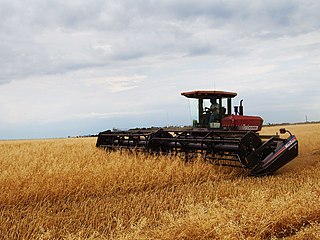Haymaking is the process of hay production and harvest.
Contents
Haymaking may also refer to:
Haymaking is the process of hay production and harvest.
Haymaking may also refer to:

Hay is grass, legumes, or other herbaceous plants that have been cut and dried to be stored for use as animal fodder, either for large grazing animals raised as livestock, such as cattle, horses, goats, and sheep, or for smaller domesticated animals such as rabbits and guinea pigs. Pigs can eat hay, but do not digest it as efficiently as herbivores do.

Pieter Bruegelthe Elder was among the most significant artists of Dutch and Flemish Renaissance painting, a painter and printmaker, known for his landscapes and peasant scenes ; he was a pioneer in presenting both types of subject as large paintings.

A reaper is a farm implement or person that reaps crops at harvest when they are ripe. Usually the crop involved is a cereal grass. The first documented reaping machines were Gallic reapers that were used in Roman times in what would become modern-day France. The Gallic reaper involved a comb which collected the heads, with an operator knocking the grain into a box for later threshing.

Jules Bastien-Lepage was a French painter closely associated with the beginning of naturalism, an artistic style that grew out of the Realist movement and paved the way for the development of impressionism. Émile Zola described Bastien-Lapage's work as "impressionism corrected, sweetened and adapted to the taste of the crowd."

A swather, or windrower, is a farm implement that cuts hay or small grain crops and forms them into a windrow for drying.
Joan of Arc (1412–1431) was a French woman who is known for her role in the Hundred Years' War and as a religious figure.

Archduke Ernest of Austria was an Austrian prince, the son of Maximilian II, Holy Roman Emperor, and Maria of Spain.

The Harvesters is an oil painting on wood completed by Pieter Bruegel the Elder in 1565. It depicts the harvest time set in a landscape, in the months of July and August or late summer. Nicolaes Jonghelinck, a merchant banker and art collector from Antwerp, commissioned this painting as part of a cycle of six paintings depicting various seasonal transitions during the year.
Events from the year 1878 in art.
The National Haymakers' Association was a side degree of the Improved Order of Red Men, similar perhaps to the Shriners within Freemasonry. Meeting places were titled Haylofts. Sometimes the meeting halls of the Redmen served as Haylofts. Offices had titles like "Collector of Straws" and "Guard of the Barn Door", and candidates for initiation were styled "Tramps" and were overseen by a "Boss Driver".

The Hunters in the Snow, also known as The Return of the Hunters, is a 1565 oil-on-wood painting by Pieter Bruegel the Elder. The Northern Renaissance work is one of a series of works, five of which still survive, that depict different times of the year. The painting is in the collection of the Kunsthistorisches Museum in Vienna, Austria. This scene is set in the depths of winter during December/January.

The Gloomy Day is an oil on wood painting by Pieter Bruegel the Elder in 1565. The painting is one in a series of six works, five of which are still extant, that depict different times of the year. The painting is currently in the collection of the Kunsthistorisches Museum, located in Vienna, Austria.

The Return of the Herd is an oil on wood painting by Pieter Bruegel the Elder in 1565. The painting is one in a series of six works that depict different seasons. The painting is currently in the collection of the Kunsthistorisches Museum, located in Vienna, Austria. The autumnal colors of the landscape and the bare trees connect this particular painting to October/November.

The Hay Harvest, is an oil painting on wood panel by Pieter Bruegel the Elder, executed in 1565. The most important of the Lobkowicz family's Northern pictures, it was hung in the dining room of the Antwerp merchant Niclaes Jongelink. This work was originally part of a series of six panels, each presumed to represent two months of the year – in this case June and July.
Lepage or LePage or Le Page is a surname that may refer to:
Land of Cockayne may refer to:

The Procession to Calvary is an oil-on-panel by the Netherlandish Renaissance artist Pieter Bruegel the Elder of Christ carrying the Cross set in a large landscape, painted in 1564. It is in the Kunsthistorisches Museum in Vienna.

A Hay Lot is a portion of common land used for haymaking and assigned by lot or allotment. Traditionally a marker, usually of stone, was used in early agriculture to mark the position of an individual hay lot within a hay meadow. The marker stone would typically bear the initials of the lot-holder. Such markers would have been common-place in meadows in Britain, but with the advent of modern farming many hay meadows were ploughed for arable crops, and the hay lots removed. Today, few such examples remain, but some can be seen in the North Meadow at Cricklade.

Haymaking or Resting in the Fields is an 1877 painting by Jules Bastien-Lepage. First exhibited at the 1878 Paris Salon, it was acquired by the Musée du Luxembourg in 1885 at the posthumous sale of the artist's works. It passed to the Louvre in 1929 and then to its current home in the Musée d'Orsay, in Paris, in 1980.

Joan of Arc is an oil on canvas painting by Jules Bastien-Lepage, from 1879. It was exhibited at the Exposition Universelle in Paris in 1889. It his held in the Metropolitan Museum of Art, in New York.